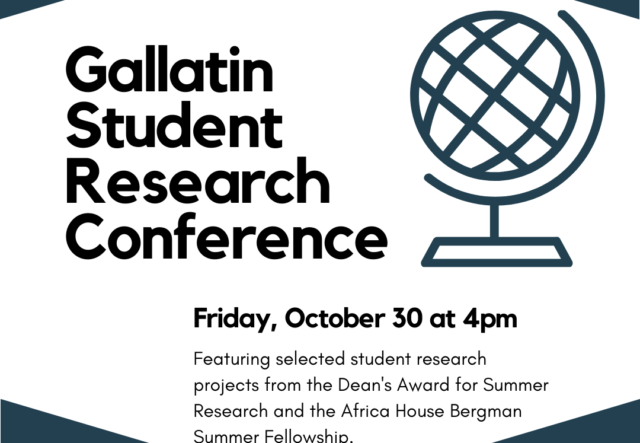Friday, October 30, 2020
Watch the 2020 virtual conference video
Featuring selected student research projects from the Dean’s Award for Summer Research and the Africa House Bergman Summer Fellowship.
Faculty Discussant Professor Jacob Remes
Panelists – Listed in Presentation Order
- Asia Lo Savio (BA ’21)
- Meagen Tajalle (BA ’21)
- Annick Saralegui (BA ’21)
- Melchior Tamisier-Fayard (BA ’21)
- Joel Lee (BA ’21)
- Caroline Shadle (MA ’21)
- Jules Talbot (BA ’22)
Keynote Panelists
Presentations will be showcased during the October conference and will be followed by a panel discussion.
——–
Asia Lo Savio (BA ’21)
Angola on The World Stage
Elinga Teatro, a theater founded in Angola by Jose Mena Abrantes in 1988, represents a piece of Angolan history. It is a vehicle through which Angola’s colonial past and anti-colonial reactions, both on the political and dramaturgical stage, can be traced and connected to the new cycle brought on with Angola’s independence. After 32 years, Elinga and Mena Abrantes’s plays continue to engage with issues, realities, and representations that define Angolan postcolonial present. Theater is a world medium and Elinga Teatro is a platform for artistic research and expression that connects Angola to the world, and the cultures and histories of the world to Angola.
Meagen Tajalle (BA ’21)
The Fences that Mark the Boundaries: Expanding the Decolonial Imagination on Guam
This project focuses on American neocolonial militarism on Guam, where the US military occupies approximately one-third of the island’s land. I discuss the pervasion of American military power through the military occupation and examine mixed attitudes toward decolonization through the lens of the metaphorical collective memory of Liberation Day, the island’s most widely-celebrated holiday which marks the end of Japanese WWII occupation after the reoccupation of the US military.
Annick Saralegui (BA ’21)
Leveraging the Power of Microbes in Cultivating Regenerative Futures
What can we learn from microbes? How has the human-microbe relationship influenced socio-environmental narratives? My research uncovers how the dualism between the human and the microbe, with the rise of the “Germ theory,” has weakened human and environmental resilience to disease and anthropocentric climate change. I also explore the powers of microbes: the ways in which they communicate and organize, as well as specific cultures in the Global South that utilize microbes in their day-to-day lives, to propose alternative ways in which humans can reimagine the human-microbe relationship.
Melchior Tamisier-Fayard (BA ’21)
Technology as a Lens for Investigating Social and Cultural Norms in Japan
What can artifacts and technologies tell us about the societies and cultures in which they are used? Through my research, I looked at the use of vending machines, air conditioners, and rice cookers in Japan, and the narratives that emerged from the way people used and viewed these objects. In doing so, I aimed to construct a view of technology as an actor within socio-cultural contexts.
Joel Lee (BA ’21)
Locating the Histories and Definitions of Bara Art & Fan Subjectivities
My research project is an inquiry as to how “bara,” an antiquated Japanese slur translating to “pansy,” became the label for a subgenre for homoerotica on the Internet. Bara’s depictions center around illustrations of hypermasculine and muscular men engaged in lewd sexual acts. Much of bara illustrations are fanmade depictions of fictional characters, which piqued my curiosity as to why that is the case. Through interviews with bara fans, moderators, and artists, my goals were to understand how participants defined “bara” for themselves, its histories and connections to Japanese erotic imagery, and their relationships to other fans and the public. Participants’s responses revealed and explored notions of high/low art, taste, taboo, and gender play.
Caroline Shadle (MA ’21)
Ruth Page’s “La Guiablesse” (1933): Collaboration, Boundary-Crossing, and Social Imagining in 1930s Chicago
My summer research, which informs my thesis, initially began as a study of Chicago-based dancer and choreographer Ruth Page’s work between the 1920s and 1940.s Over time, I focused on two presentations of Page’s 1933 ballet “La Guiablesse.” Through archival research, historical analysis, and a literature review, I argue that “La Guiablesse” functioned as a unique site of cross-artistic, cross-cultural, and interracial collaboration and boundary crossing, as well as an opportunity to imagine social possibilities, for those participating in the ballet onstage and off.
Jules Talbot (BA ’22)
I Am Dead, Horatio
My project is a graphic novel adaptation of Hamlet called I Am Dead, Horatio, retold from the point of view of the play’s sole survivor. When Hamlet asks Horatio to “report [him] and [his] cause aright,” it begs the question of what it means to tell someone else’s story. Who will tell Horatio’s? Expanding on the play’s themes of grief, remembrance, and biography, it explores the aftermath of a Shakespearean tragedy. This project is informed by my research this summer on comics adaptations—specifically, adaptations of Shakespeare—and the complicated relationship of derivative works and their source material.
